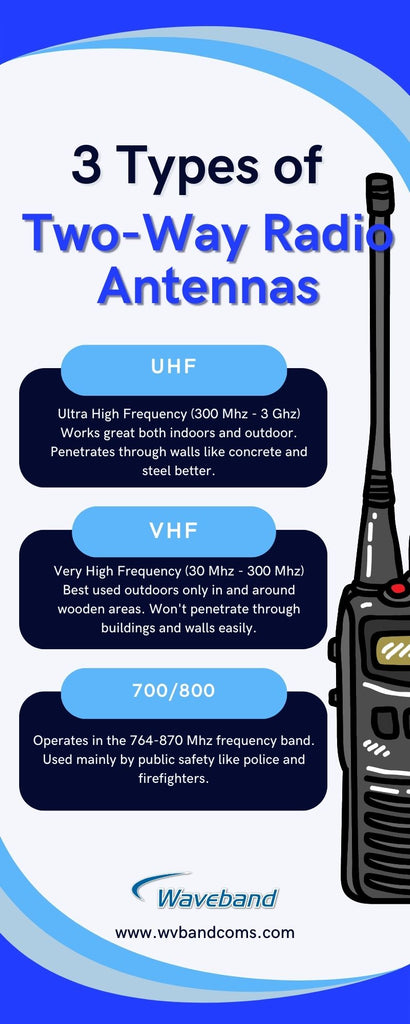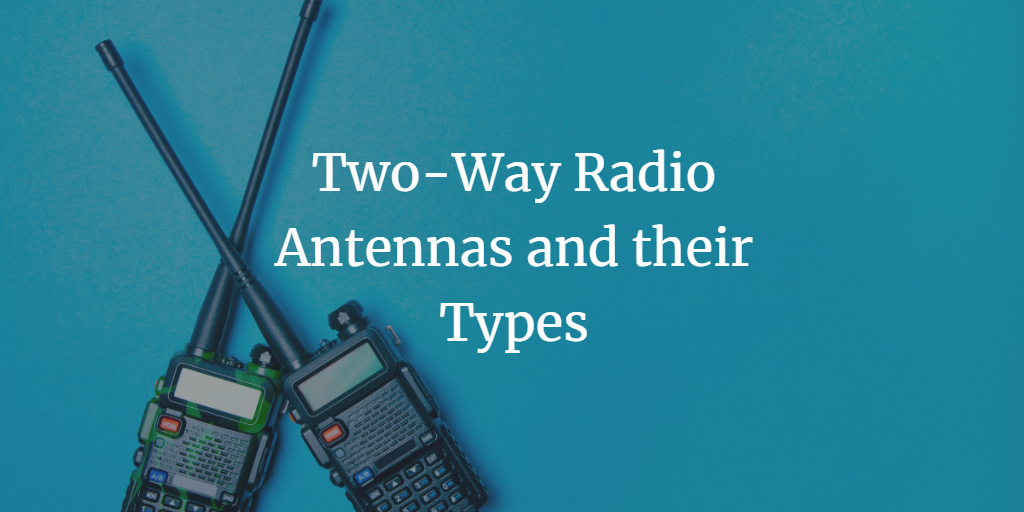Antennas are used to help extend the range of your two-way radio. The range is how far your two-way radio can communicate. Improving your antenna will allow you to communicate across larger distances. There are several types of antennas that are best suited for different applications. We’ll go over the different types of two-way radio antennas to help you figure out which is best for you.
Types and their best application
Antennas have frequency bands, measured in MHz, that fall into different wavelengths. To keep it simple, the higher the frequency the greater the range. There are 3 different types of antenna frequencies, UHF, VHF, and 700/800.
VHF
VHF stands for Very High Frequency with a frequency range of 30 MHz to 300 MHz. VHF antennas work best in outdoors only when around or in wooded areas. This type of antenna does not penetrate through walls very well which can interfere with coverage.
UHF
UHF stands for Ultra High Frequency with a frequency range of 300 MHz to 3 GHz. UHF works well for both indoor and outdoor use. This type of antenna penetrates through walls like concrete and steel, better than VHF. UHF is the most popular of the two.
700/800
700/800 MHz antennas operate in several portions of the 700/800 frequency band with a range of 764-870 MHz. Many public safety radios (police, fire, EMS) operate within this range.

Stubby vs Whip vs Helical
Antennas come in all sorts of sizes. Ultimately, the higher the frequency, the shorter the wavelength and the smaller the antenna. Antenna size and type influence range. Longer antennas have a better range than smaller ones.
Whip
Whip antennas are about 7-8 inches long and skinny in size. These typically have more gain which helps increase the range of your two-way radio. A downside to the Whip antenna we hear often is the length of the antenna is too long. When radios are kept at your waist (on a utility belt), the antenna nudges them while they’re sitting which can make it uncomfortable.
Stubby
Stubby antennas get their name from their length. They are about 3-4 inches long, although, we’ve seen antennas for around 2 inches. Stubby antennas are best for UHF and 700/800 MHz frequency bands. Due to their length, the stubby antenna is favored by everyday radio users because it’s less intrusive and won’t poke you in the side, compared to whip antennas.
Because stubby antennas are so small, depending on your frequency, you could be sacrificing the range of your two-way radio. If you’re needing a VHF antenna, a stubby antenna is not recommended. You’re not going to get the range you need – look for a helical or whip with a higher gain.
Helical
Helical antennas vary in length and are thicker in size. Like whip antennas, these offer a great range for your two-way radio.
How to choose a radio antenna?
Compatibility
The most important thing to know when buying a radio antenna is that it operates on your radio’s frequency. For example, if your radio operates on a 406 MHz frequency, you need an antenna that will cover that band. In this case, a UHF antenna would work.
GPS
Newer radios are becoming integrated with GPS capabilities for location services. If your radio is using GPS, you need to use a GPS-capable antenna.
Care
We wanted to leave you with a helpful tip on caring for your antenna to keep your radio transmitting properly. Never chew on, hold, or swing the radio by the antenna. This will cause your antenna to bend which significantly decreases its life. If your antenna is damaged, find a replacement right way so you don’t lose communication with your team.

Need help finding the right antenna for your radio? Waveband Communications can help! We have UHF, VHF, and 700/800 antennas for the most popular two-way radios on the market today.



